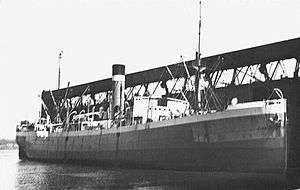SS City of Johannesburg
 | |
| History | |
|---|---|
| Name: | City of Johannesburg |
| Operator: | Ellerman Lines Ltd, London |
| Port of registry: |
|
| Builder: | Barclay, Curle & Co, Whiteinch, Glasgow |
| Yard number: | 581 |
| Launched: | 23 May 1920 |
| Completed: | 1920, as the Melford Hall |
| Identification: | UK official number 143712 |
| Fate: | sunk on 23 October 1942 |
| General characteristics | |
| Class and type: | cargo steamship |
| Tonnage: | |
| Length: | 417.2 ft (127.2 m) |
| Beam: | 54.8 ft (16.7 m) |
| Depth: | 29.0 ft (8.8 m) |
| Propulsion: | 2 steam turbines double-reduction geared onto a single shaft |
| Crew: | 89 |
SS City of Johannesburg was a British cargo steamship that was sunk in the Second World War. She was built by Barclay, Curle & Co, of Whiteinch, Glasgow for Ellerman Lines Ltd, of London in 1920, being launched as SS Melford Hall. She was renamed SS City of Johannesburg in 1926 and registered in Liverpool.
Career and sinking
Her final voyage was to take her from Calcutta to the United Kingdom, calling at Colombo on 6 October and later at Cape Town on the way. She carried 7,750 tons of general cargo, including pig iron, cotton, jute and tea, under the command of her master, Walter Armour Owen.
At 2312 hours on 23 October 1942, she was travelling unescorted off East London South Africa, when she was sighted by German submarine U-504 commanded by Fritz Poske. The U-boat torpedoed the City of Johannesburg, and succeeded in sinking her. Two of the 89 crew were lost, but the master and 12 crew members were rescued by the Dutch cargo ship Zypenberg, which took them to Durban. Another 54 crew members were rescued by the British cargo ship Fort George and landed at Port Elizabeth, with the final 20 crew members being picked up by King Edwin, which took them to Cape Town.
References
Coordinates: 33°20′S 29°30′E / 33.333°S 29.500°E